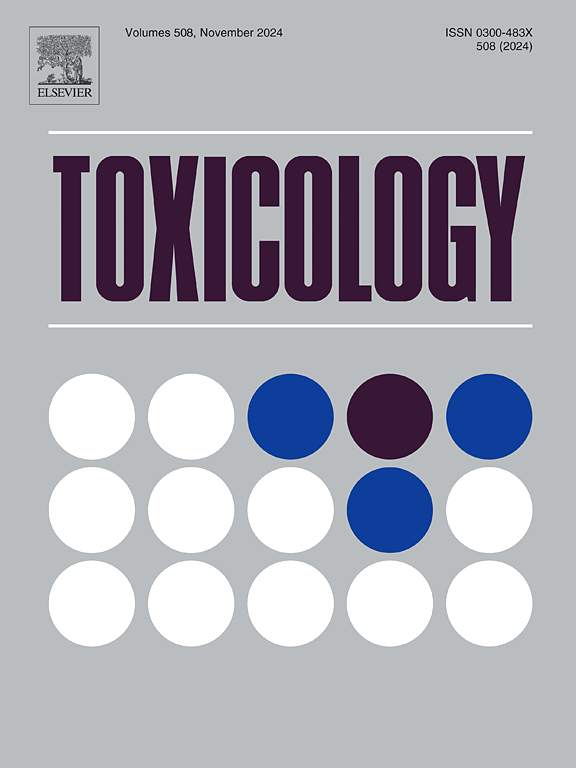Identification of key genes linking bisphenols exposure and breast cancer
IF 4.8
3区 医学
Q1 PHARMACOLOGY & PHARMACY
引用次数: 0
Abstract
Breast cancer (BC) is one of the most common types of cancer and is caused by the complex interplay of genetic and environmental factors, such as an unhealthy lifestyle, family history of illness, reproductive factors, and ageing. However, increasing evidence has revealed that manufactured organic pollutants such as bisphenols are closely related to BC. Bisphenols exposure can promote the progression of BC through multiple complicated and variable molecular mechanisms. Reanalysis of existing data on this topic may reveal molecular markers with clinical value. In this study, we identified four key genes [keratin 14 (KRT14), keratin 5 (KRT5), acyl-CoA synthetase long chain family member 1 (ACSL1) and matrix metallopeptidase 1 (MMP1)] related to both bisphenols exposure and BC by employing the Comparative Toxicogenomics Database (CTD) and The Cancer Genome Atlas Cervical Cancer (TCGA-CESC) dataset; notably, KRT14 expression exhibited the most significant difference between tumour and normal tissues. Further analysis of the functions and biological processes associated with KRT14 and related regulatory molecules revealed that bisphenols exposure induces BC-promoting characteristics and aggressive behaviour-related signaling pathways, such as the steroid biosynthesis, Forkhead box (FOXO) and prolactin signaling pathways. To confirm the expression and biological effects of KRT14, we conducted relevant experiments. In vitro studies revealed that bisphenols such as bisphenol A (BPA) exposure significantly affected the proliferation, migration, and invasion of MCF-7 cells by inhibiting KRT14 expression. Similarly, we also observed a decrease in KRT14 expression in BPA induced abnormal breast tissue in mice. In summary, our study revealed potential genes and pathways associated with bisphenols exposure in BC.
双酚暴露与乳腺癌相关的关键基因鉴定
乳腺癌(BC)是最常见的癌症类型之一,是由遗传和环境因素复杂的相互作用引起的,如不健康的生活方式、家族史、生殖因素和衰老。然而,越来越多的证据表明,双酚类等人造有机污染物与BC密切相关。双酚暴露可通过多种复杂多变的分子机制促进BC的进展。重新分析关于这一主题的现有数据可能会发现具有临床价值的分子标记。在这项研究中,我们利用比较毒物基因组数据库(CTD)和宫颈癌基因组图谱(TCGA-CESC)数据集,确定了与双酚暴露和BC相关的四个关键基因[角蛋白14 (KRT14),角蛋白5 (KRT5),酰基辅酶a合成酶长链家族成员1 (ACSL1)和基质金属肽酶1 (MMP1)];值得注意的是,KRT14的表达在肿瘤组织和正常组织中表现出最显著的差异。进一步分析与KRT14和相关调控分子相关的功能和生物学过程发现,双酚暴露诱导bc促进特征和攻击性行为相关的信号通路,如类固醇生物合成、叉头盒(FOXO)和催乳素信号通路。为了确认KRT14的表达及其生物学效应,我们进行了相关实验。体外研究表明,双酚A (BPA)等双酚类物质通过抑制KRT14的表达,显著影响MCF-7细胞的增殖、迁移和侵袭。同样,我们也观察到KRT14在BPA诱导的小鼠异常乳腺组织中的表达降低。总之,我们的研究揭示了与BC双酚暴露相关的潜在基因和途径。
本文章由计算机程序翻译,如有差异,请以英文原文为准。
求助全文
约1分钟内获得全文
求助全文
来源期刊

Toxicology
医学-毒理学
CiteScore
7.80
自引率
4.40%
发文量
222
审稿时长
23 days
期刊介绍:
Toxicology is an international, peer-reviewed journal that publishes only the highest quality original scientific research and critical reviews describing hypothesis-based investigations into mechanisms of toxicity associated with exposures to xenobiotic chemicals, particularly as it relates to human health. In this respect "mechanisms" is defined on both the macro (e.g. physiological, biological, kinetic, species, sex, etc.) and molecular (genomic, transcriptomic, metabolic, etc.) scale. Emphasis is placed on findings that identify novel hazards and that can be extrapolated to exposures and mechanisms that are relevant to estimating human risk. Toxicology also publishes brief communications, personal commentaries and opinion articles, as well as concise expert reviews on contemporary topics. All research and review articles published in Toxicology are subject to rigorous peer review. Authors are asked to contact the Editor-in-Chief prior to submitting review articles or commentaries for consideration for publication in Toxicology.
 求助内容:
求助内容: 应助结果提醒方式:
应助结果提醒方式:


